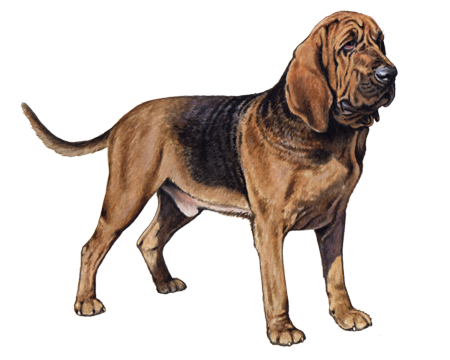
Transylvanian Hound (Erdélyi Kopó)
The Transylvanian Hound is an all-around good-natured and even-keeled dog, with a lively spirit. Their background has made them a tough breed, adaptable to any situation, and are playful enough to make a great family pet. They are also quiet and determined, and built to endure any weather condition.
Interested in discovering if your dog is a Transylvanian Hound (Erdélyi Kopó)?
Check out Wisdom Panel's DNA tests.

Transylvanian Hound (Erdélyi Kopó) Traits
General Appearance
The Transylvanian Hound is a medium-sized breed that’s muscular and streamlined, with dark brown, almond-shaped eyes and droopy, medium-high ears that hang close to their cheeks.
Coat and Coloring
The Transylvanian Hound has a short, straight, dense coat that’s tan and black. They can have white markings, but not covering more than one-fifth of the body.
Transylvanian Hounds can have white markings on the nose that extends to a blaze on the forehead. They can also have white markings around their neck, on the lower parts of the legs and feet, and on the tip of the tail. They have a light tan point on each eyebrow and tan markings on their legs and muzzle.
Distinctive Physical Traits
The Transylvanian Hound has an appearance that’s in line with its personality—noble and strong. They have a medium-sized, athletic body, and they can withstand extreme weather conditions.
Transylvanian Hound (Erdélyi Kopó) Temperament
This stoic Hungarian breed carries with it a lot of noble traits from its days hunting in the Carpathian mountains. At home, they are good-natured and loyal.
With an active streak, the Transylvanian Hound is even-tempered and brave, making the breed a good candidate for guard dog duty.
Transylvanian Hounds make excellent family pets, as long as they are provided with ample exercise every day since they are very active.


Transylvanian Hound (Erdélyi Kopó) History
The Transylvanian Hound (or Erdelyi Kopó in its native language) hails from Hungary. During the Middle Ages, the Hungarian aristocracy preferred the Transylvanian Hound as a hunting companion.Because of the varied terrain where they hunted, the breed eventually developed into two separate varieties, one with short and one with long legs. Both versions of the breed neared extinction during the 20th century, but breeders revived the Transylvanian Hound starting in 1968. Although the short-legged version of the dog did eventually become extinct, the better-suited long-legged version of the Transylvanian Hound can now be found mostly in Hungary and Romania.
Transylvanian Hound (Erdélyi Kopó) Care
Nutrition
The Transylvanian Hound is an active breed that does best with high-quality dog food that’s suited to their particular age, as well as any additional health concerns.
As with any dog, it’s important to monitor the amount of food and treats that you give your Transylvanian Hound, especially since some older dogs are prone to gaining weight as they age. Your veterinarian is always a good source to help provide you with appropriate nutrition and feeding guidelines.
Grooming
This breed has a short coat that requires minimal care. Brushing it once a week with a strong bristle brush or a grooming mitt should be plenty.
All dogs require regular dental care, including at-home teeth brushing and professional dental cleanings, and the Transylvanian Hound is no exception. Maintaining good dental hygiene is important for their overall long-term health.
Exercise
The Transylvanian Hound is an active breed, and they need plenty of stimulation every single day to stay happy and healthy. They enjoy activities they can do with their families—an hour-long walk or run will make them happy—and they make great candidates for dog sports like agility and rally.
Training
As a hunting breed, the Transylvanian Hound can find it difficult to ignore their given instincts and can be stubborn. Although they are smart enough to train, that doesn’t mean they always want to. Like with all dogs, both early training and socialization are important to teach them proper boundaries.

Breed Group
Hound
The most common ancestral trait of this group is being used for hunting. Some use acute powers of scent to follow a trail while others demonstrate the gift of stamina as they run down a quarry. Beyond these two common traits, however, generalizations about hounds are hard to come by as the group is comprised of a very diverse lot of breeds.


































